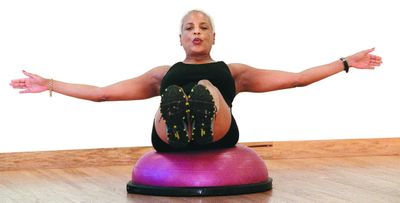Building Stability
Balance-specific exercises can fend off some of aging’s reflex effects

There are times in your life when feeling a little off-balance may actually be a good thing. Take it from the experts. Although there are some changes you can’t avoid as you get older, including deterioration of your hearing, vision and coordination, research suggests that it’s worth taking steps – even risking a few missteps – to slow the decline in your balance.
Loss of balance makes us vulnerable to falls, which can be dangerous at any age but is the fifth-leading cause of death for people 65 and older, according to the Centers for Disease Control and Prevention.
The CDC makes a number of recommendations to prevent falls, including exercising regularly to maintain muscle and getting enough Vitamin D and calcium to preserve bone strength.
But a growing number of physicians, physical therapists and personal trainers go further, advocating exercises designed to challenge the complex system of reflexes that governs our stability and spatial orientation.
And, as Roger Yasin, a personal trainer in Arlington, Va., puts it, it’s smart for younger people to start doing these exercises.
Yasin said many of his clients are surprised to find out how their balance declines over time, and they often underestimate how important balance is to navigating the hazards in their daily lives, from escalators to uneven sidewalks and grassy hills.
“Many people don’t think of balance when they think of personal training; they think of diet and weight loss, or they want to get ready for a wedding or reunion.”
Whether you’re preparing for an event or doing your regular workout routine, Yasin and others recommend including exercises that address your balance.
Doing so has the added advantage of helping you lose weight. “Since you are trying to stabilize your body, you’re using multiple muscle groups and can burn so many more calories,” he said.
Yasin said everyone should start by balancing on the floor with one foot, before progressing to challenging equipment.
The following are a few of the many products aimed at different levels of fitness and expertise. Consult your trainer or doctor before choosing one that’s right for you.
•Balance pads look like thick gymnastics mats but feel much softer. The feeling of instability created by the pad’s foam surface increases as the user puts more weight on it. It can be used for rehabilitation, exercise and coordination training. Performing lunges, push-ups or sit-ups on a balance pad improves overall strength and stability. By stacking two pads on top of one another, the user can create greater instability for a tougher workout.
•Bosu ball – The Bosu, whose name stands for “Both Sides Utilized,” resembles half a ball, with one flat and one domed side; it can be used for cardio, balance-building workouts or yoga. Users can sit, stand or squat on the curved side and sit or try push-ups on the flat side, all while trying to maintain balance as the body shifts to compensate for the movement of the ball.
•Dyna-Disc – Yasin says the squishy surface of this circular, air-filled mat makes his clients feel as if they’re stepping on a deflated football. People of all ages can sit, stand or lie on the disks to improve posture and balance in the lower body. The Dyna-Disc is made from the same material as a gym ball but is more stable since it can’t roll away. It comes in different sizes suitable for a variety of exercises. Users can perform curls or other moves standing on the disk to strengthen core muscles. They can change the inflation level of the disk or stand with one under each foot to increase exercise difficulty.
•Bongo board – This skateboardlike board is the most difficult of these products to use. It’s designed to improve coordination by challenging the user to keep the board stable over a rolling wheel. The Bongo board is for more-advanced users and can also be used for push-ups to strengthen core muscles.
Other products are being created for people whose balance has decreased, whether through age or illness, and are geared toward preventing falls:
•Insoles inspired by NASA technology that helps astronauts keep their balance in space use sensors to record information about a person’s ability to balance. Erez Liebermann, a graduate student at the Harvard-MIT Division of Health Sciences and Technology, began working on the iShoe insole as a NASA intern; it could be available in 18 months and cost about $100, according to the division’s Web site.
Another product in development is the vibrating insole, or “noise-enhanced sensory function.” Its inventor, Jim Collins, says it is intended to help elderly people detect changes in their environment, increase sensitivity to their surroundings and improve their balance. Collins said the insole is beginning the process of winning approval from the Food and Drug Administration.
If you don’t frequent the gym but would still like to avoid falls, Scott McCredie, author of “Balance: In Search of the Lost Sense,” says you don’t need gadgets to improve your stability or core strength.
“All you need to do is stand on one leg in various poses, and you can do that anywhere,” McCredie said, whether “waiting for the bus or brushing your teeth in the bathroom.”
Physical therapist Kristine Legters takes this low-tech approach by incorporating balance training into her clients’ everyday lives.
“Standing on a pillow, walking on grass as opposed to concrete, or looking around and moving your head while walking as opposed to looking straight challenges and improves your balance,” said Legters, who works in Pennsylvania.
The takeaway message is clear: To maintain your stability as you get older, you need to throw yourself off-balance once in a while.